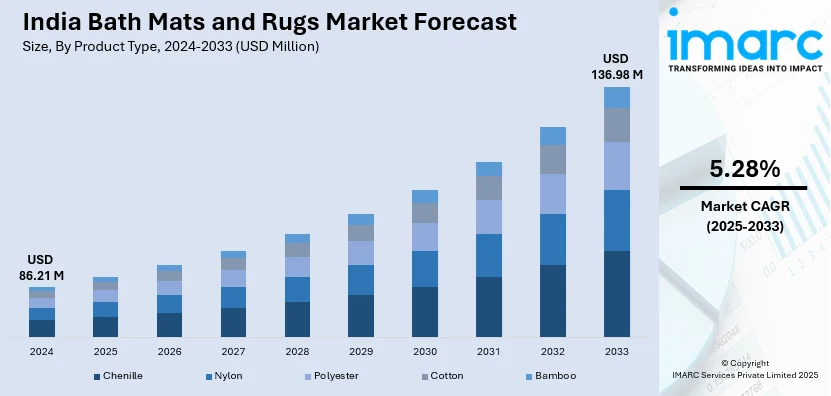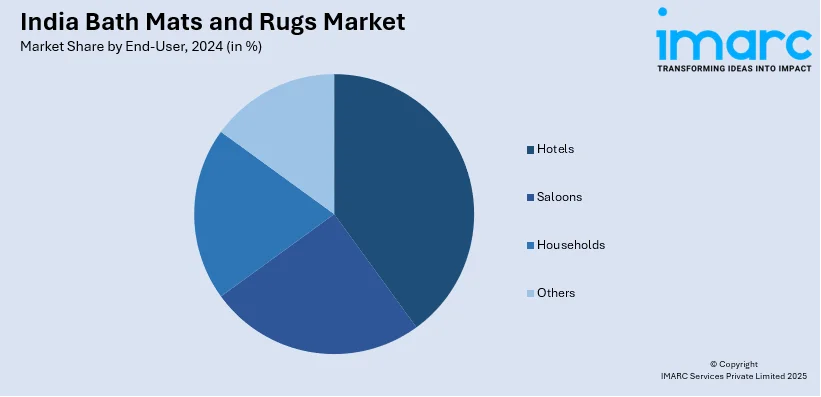
India Bath Mats and Rugs Market Size, Share, Trends and Forecast by Product Type, End-User, and Region, 2025-2033
India Bath Mats and Rugs Market Overview:
The India bath mats and rugs market size reached USD 86.21 Million in 2024. Looking forward, IMARC Group expects the market to reach USD 136.98 Million by 2033, exhibiting a growth rate (CAGR) of 5.28% during 2025-2033. The rising urbanization, increasing disposable income, expanding real estate and hospitality sectors, shifting consumer preference for premium and sustainable home textiles, growth in e-commerce, and growing awareness of hygiene and comfort in residential and commercial spaces are some of the major factors positively impacting the India bath mats and rugs market share.
|
Report Attribute
|
Key Statistics
|
|---|---|
|
Base Year
|
2024 |
|
Forecast Years
|
2025-2033
|
|
Historical Years
|
2019-2024
|
| Market Size in 2024 | USD 86.21 Million |
| Market Forecast in 2033 | USD 136.98 Million |
| Market Growth Rate 2025-2033 | 5.28% |
India Bath Mats and Rugs Market Trends:
Influence of Urbanization and Lifestyle Changes
The rapid expansion of urban living spaces is transforming purchasing patterns, particularly in home décor, which is positively influencing India bath rugs and mats market outlook. According to the World Bank Group, by 2036, there will be 600 million people residing in towns and cities, making approximately 40% of the total population in India, compared to 31% in 2011, and more than 70% of GDP will come from metropolitan areas. As cities grow, modern apartments and homes increasingly emphasize coordinated interiors, where bath mats and rugs serve not only as functional necessities but also as aesthetic elements that enhance overall design. Consumers are increasingly choosing designs that match their bathroom themes, integrating colors and textures that reflect personal style. The shift towards contemporary, minimalist, and luxury home setups has encouraged demand for premium, designer, and customized bath mats. Soft-touch, quick-drying, and anti-slip features are now considered essential, particularly in urban households with busy lifestyles. Additionally, online retail platforms have made stylish and high-quality options more accessible, providing consumers with an extensive range of choices. Urban professionals are also showing a preference for low-maintenance mats that require minimal washing and drying time. This shift is leading brands to innovate with advanced fabric treatments that offer antibacterial properties and enhanced durability, meeting the evolving needs of modern living.

To get more information on this market, Request Sample
Growth of the Hospitality Industry
Luxury hotels, resorts, and boutique accommodations are focusing on premium bathroom experiences, creating a growing market for high-end bath mats and rugs. According to industry reports, India luxury hotel market size reached USD 2.7 Billion in 2024, and the market is expected to reach USD 6.2 Billion by 2033, exhibiting a growth rate (CAGR) of 8.83% during 2025-2033. This increases the demand for high-quality bathroom accessories. As hospitality businesses invest in enhancing guest comfort, premium bath mats, and rugs are becoming essential elements in elevating bathroom aesthetics and functionality. Soft, plush textures and visually appealing designs contribute to the perception of comfort and hygiene in hospitality spaces. Hotels prioritize materials that offer high absorbency, durability, and quick-drying properties to ensure frequent use without compromising aesthetics. The need for uniformity across multiple rooms also pushes for bulk purchases of coordinated bathroom accessories, including mats in matching color schemes and branded embroidery, which is facilitating India bath rugs and mats market growth. Hygiene remains a top concern, leading to increased use of antimicrobial-treated fabrics that reduce bacterial growth and odors. Hospitality businesses are also exploring custom branding on bath mats to enhance their identity. This sector’s emphasis on premium experiences influences homebuyers, as individuals seek to replicate the comfort of hotel-style bathrooms in their residences, driving further demand for quality bathmats and rugs.
India Bath Mats and Rugs Market Segmentation:
IMARC Group provides an analysis of the key trends in each segment of the market, along with forecasts at the country level for 2025-2033. Our report has categorized the market based on product type and end-user.
Product Type Insights:
- Chenille
- Nylon
- Polyester
- Cotton
- Bamboo
The report has provided a detailed breakup and analysis of the market based on the product type. This includes chenille, nylon, polyester, cotton, and bamboo.
End-User Insights:

- Hotels
- Saloons
- Households
- Others
A detailed breakup and analysis of the market based on the end-user have also been provided in the report. This includes hotels, saloons, households, and others.
Regional Insights:
- North India
- South India
- East India
- West India
The report has also provided a comprehensive analysis of all the major regional markets, which include North India, South India, East India, and West India.
Competitive Landscape:
The market research report has also provided a comprehensive analysis of the competitive landscape. Competitive analysis such as market structure, key player positioning, top winning strategies, competitive dashboard, and company evaluation quadrant has been covered in the report. Also, detailed profiles of all major companies have been provided.
India Bath Mats and Rugs Market News:
- On December 6, 2024, Jaipur Rugs announced the 'Jardins du Monde' collection, a collaboration with Paris-based designer Tatiana de Nicolay. This series comprises seven distinct designs, each drawing inspiration from renowned gardens worldwide, such as the Albert Kahn gardens in Paris and English meadows. Handcrafted by artisans in Rajasthan, these rugs encapsulate the essence of diverse landscapes, blending traditional craftsmanship with contemporary design.
India Bath Mats and Rugs Market Report Coverage:
| Report Features | Details |
|---|---|
| Base Year of the Analysis | 2024 |
| Historical Period | 2019-2024 |
| Forecast Period | 2025-2033 |
| Units | Million USD |
| Scope of the Report |
Exploration of Historical Trends and Market Outlook, Industry Catalysts and Challenges, Segment-Wise Historical and Future Market Assessment:
|
| Product Types Covered | Chenille, Nylon, Polyester, Cotton, Bamboo |
| End-Users Covered | Hotels, Saloons, Households, Others |
| Regions Covered | North India, South India, East India, West India |
| Customization Scope | 10% Free Customization |
| Post-Sale Analyst Support | 10-12 Weeks |
| Delivery Format | PDF and Excel through Email (We can also provide the editable version of the report in PPT/Word format on special request) |
Key Questions Answered in This Report:
- How has the India bath mats and rugs market performed so far and how will it perform in the coming years?
- What is the breakup of the India bath mats and rugs market on the basis of product type?
- What is the breakup of the India bath mats and rugs market on the basis of end-user?
- What is the breakup of the India bath mats and rugs market on the basis of region?
- What are the various stages in the value chain of the India bath mats and rugs market?
- What are the key driving factors and challenges in the India bath mats and rugs market?
- What is the structure of the India bath mats and rugs market and who are the key players?
- What is the degree of competition in the India bath mats and rugs market?
Key Benefits for Stakeholders:
- IMARC’s industry report offers a comprehensive quantitative analysis of various market segments, historical and current market trends, market forecasts, and dynamics of the India bath mats and rugs market from 2019-2033.
- The research report provides the latest information on the market drivers, challenges, and opportunities in the India bath mats and rugs market.
- Porter's five forces analysis assist stakeholders in assessing the impact of new entrants, competitive rivalry, supplier power, buyer power, and the threat of substitution. It helps stakeholders to analyze the level of competition within the India bath mats and rugs industry and its attractiveness.
- Competitive landscape allows stakeholders to understand their competitive environment and provides an insight into the current positions of key players in the market.
Need more help?
- Speak to our experienced analysts for insights on the current market scenarios.
- Include additional segments and countries to customize the report as per your requirement.
- Gain an unparalleled competitive advantage in your domain by understanding how to utilize the report and positively impacting your operations and revenue.
- For further assistance, please connect with our analysts.
 Request Customization
Request Customization
 Speak to an Analyst
Speak to an Analyst
 Request Brochure
Request Brochure
 Inquire Before Buying
Inquire Before Buying




.webp)




.webp)












